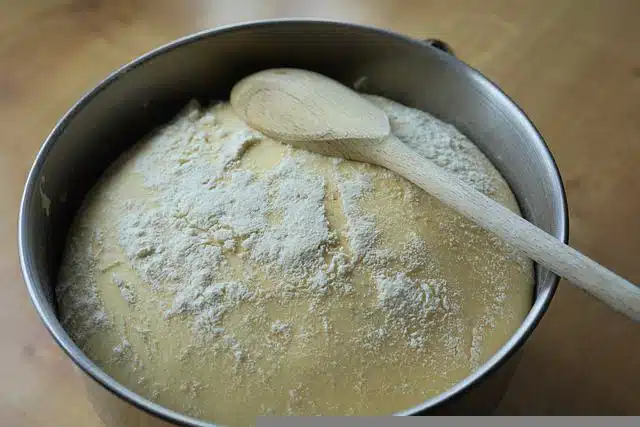In baking bread, what makes it taste and look good comes down to a few basic things. This article breaks down those key elements to help you understand how color and flavor happen in your daily bread.
The taste and browning of bread crust are largely influenced by the selection of ingredients, the duration of fermentation, and the occurrence of the Maillard reaction.
The Maillard Reaction’s Influence on Bread’s Color and Flavor
I will guide you through a fascinating chemical process known as the Maillard Reaction, which is essential to crafting delicious, nice-looking bread. This reaction is what transforms a pale piece of dough into a warm, inviting loaf with a golden-brown crust that smells and tastes awesome.
When proteins and reducing sugars within the bread dough are exposed to heat during baking, they tangle in a complex chemical reaction known as the Maillard Reaction. I’m talking about the interplay between amino acids and sugars that creates flavorful compounds and pigments, giving the bread crust its distinctive color and flavor that we all love.
The flavor complexity delivered by the Maillard Reaction isn’t one-dimensional. It varies with temperature, time, and the types of amino acids and sugars in the dough. Different kinds of bread exhibit distinctive tastes partly due to this variable chemistry. Sourdough’s tangy profile and a baguette’s subtle sweetness are both created through the Maillard Reaction.
In my opinion, understanding how the Maillard Reaction influences bread’s crust is just one aspect of the broader topic of factors that shape a loaf’s character. Let’s move forward and examine the roles that sugars, proteins, and even salt play in baking bread that doesn’t just look good and has a wonderful flavor.
Ingredients That Influence Bread’s Hue and Flavor
When you’re seeking that perfect slice of bread, you’re probably looking for a pleasant aroma, rich flavor, and a nice golden crust. But how exactly do the bread’s ingredients determine these characteristics? I’m going to guide you through the key ingredients that are essential in baking bread with great color and taste.
Sugars and Proteins
First off, let’s talk about the crucial relationship between sugars and proteins. Don’t worry too much about the complex biochemistry; just know that when proteins in flour meet the sugars, they undergo a high-heat process during baking that leads to the deliciously toasted crust we all love. This isn’t just about aesthetics; this process directly contributes to the depth of flavor in the crust.
For further information on the role of sugar in baking, you may wish to explore my article on what happens when you don’t add sugar to bread dough.
Salt
Now, what about salt? While salt does not directly contribute to browning, it’s a flavor enhancer, amplifying the natural flavors of the ingredients. If you want to bake bread that always leaves people craving another slice, don’t skimp on the salt – it’s there to make sure the bread’s flavor profile is robust and balanced.

Flour
Choosing the right flour is important, as it defines the character of the bread. Different flour types, from whole wheat to rye to enriched white flour, have varying amounts of protein, which, in turn, can influence both flavor and color. Hearty flours like whole wheat bring a nuttiness to the table, while refined flours provide a more subtle and soft flavor.
Raising Agents
Now, let’s take a look at the raising agents and their impact on the color and flavor of your bread. The choice of leavening agents, whether it’s commercial yeast, natural sourdough starter, or baking powder, can significantly influence the final product. Each type brings its distinct character to the bread. The raising agent is more than just a leavening agent; it’s a component that contributes to the overall taste profile and appearance of your bread.
While raising agents like yeast and sourdough starter do not directly contribute to browning in the way sugars do, they play essential roles that indirectly affect the crust color. The fermentation process influenced by raising agents can indirectly affect the Maillard reaction and, consequently, the color of the bread crust.
Natural Additions
Incorporating natural additions can greatly improve classic bread. Think seeds like sesame or poppy, herbs like rosemary or thyme, or even spices like cinnamon or turmeric. Not only do they add specks of color and bursts of flavor, but they also transform each loaf into a unique taste experience. Choose something that resonates with you and the type of bread you’re baking.
The Importance of Fermentation Time
If you’re aiming to make bread that stands out in flavor, then you can’t overlook the process of fermentation. It’s not just a waiting game; it’s a crucial phase where the taste and aroma deepen. Let’s examine how the length of this stage can transform your loaf from ordinary to extraordinary.
Fermentation time doesn’t just influence the bread’s taste; it also affects the color of the crust. Shorter fermentation periods lead to lighter-colored and blander bread, while extended times allow for a richer hue and more complex flavor profiles to develop. Consider fermentation as the time you give your bread to mature and develop character.
Ever bitten into a piece of bread and experienced rich, complex flavors? That’s the beauty of slow fermentation. The yeast slowly converts sugars, creating subtle tangs and deeper tastes that can only develop over time. Contrast this with the rapid rise of commercial yeast-based breads, and you’ll understand why some breads simply taste better.

Balancing fermentation length is crucial, though. Over-fermentation can lead to a sour taste and compromised structure, while under-fermentation results in an underwhelming flavor and density. Finding that sweet spot is key for baking bread that both looks and tastes fantastic.
Time plays a pivotal role in the baker’s work; the length of fermentation in bread baking influences the development of color and flavor.
Final Thoughts
Bread baking is as much a science as it is an art. It’s a delicate balance of timing, temperature, ingredients, and technique that results in the perfect loaf. Every decision you make, from the flour you choose to how long you let the dough ferment, can alter the color and flavor of your bread in subtle yet significant ways.
Creating flavor isn’t just a byproduct of baking bread; it’s the goal. Through the interaction of proteins, sugars, and heat, bakers produce flavors ranging from the nutty sweetness brought on by the Maillard Reaction to the complex sourness of a well-fermented dough. As you’ve learned, salt is not just a seasoning; it’s a flavor enhancer that also impacts the dough’s color. Flour, while it might seem like just a base ingredient, carries a taste profile that can dramatically affect your bread.
The beauty of baking bread lies in the way these components interact—how fermentation deepens the taste, how natural additions can introduce new and exciting flavors and colors, and how a finely tuned baking process can lead to that perfect crust and deliciousness in every bite.
I hope that you’ve picked up some valuable insights into the complex world of bread baking and feel inspired to experiment with your loaves. Remember, your first attempt doesn’t need to be your last; baking is a journey of learning and discovery.
If you liked this article, you may wish to discover more bread-baking tips in our other blog posts. Share your thoughts in the comments and feel free to share on social media.

